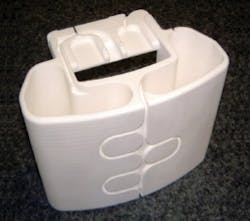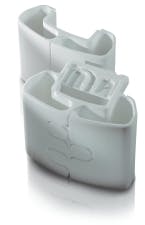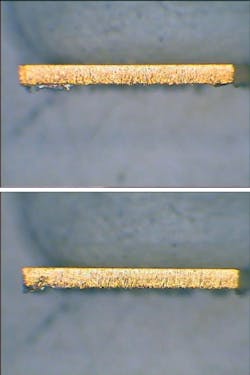Update: Industrial laser applications in Slovakia, Laser sintering reduces number of components, and Golden opportunity for lasers
Industrial laser applications in Slovakia
NOVÈ MESTO, SLOVAKIA - Industrial laser applications appeared in Slovakia, a small country in Central Europe which was part of Czechoslovakia until 1993, at the end of the 1970s and early 1980s, primarily in research institutes. Information on this new technology came from the Czech Republic (where the first laser activities began in the 1960s), literature (mainly from Russia), and visits to the trade shows in Western Europe.
Some research institutes – such as the Research Institute for Mechanization and Automation (VUMA), the Glass research institute, the Wood research institute and the Welding institute in Slovakia – have started to work with laser technology in areas such as metal and wood cutting, glass decorating, and welding using imported laser sources (mainly CO2). The first laser industrial equipment used in Slovakia was from foreign laser sources, the Czech Republic, East Germany, and the U.S., with the machinery and controls built in Slovakia.
In 1980 the first 1 kW CO2 Sylvania GTL 971 was brought to VUMA in order to better understand the construction of high power lasers and start research and development on high power laser applications.
At this time, two research projects started at VUMA: the developments of a 1 kW CO2 laser and Nd:YAG lasers (pulsed and Q-switched) for the electronic industry.
As a result, the first laser radiation from the 1 kW CO2 laser designed and built in Slovakia occurred in March 1983. The laser, an unstable resonator with a ring laser beam, was used for surface heat treatment and alloying applications. Over the next four years, three units were produced and used in technical universities and the Welding institute.
The results of the second research project, solid state lasers for the electronic industry, produced a 50 W pulsed Nd:YAG laser and 40W and 100W Q-switched YAG lasers. From 1984 to 1989, eight pulsed Nd:YAG lasers were produced for micro-welding applications and 14 laser systems for trimming, silicon wafer marking and pyrolytic graphite cutting applications. In the second half of this decade, six to eight laser systems for decorating glass were produced by workers from the Glass Research Institute.
The transformation from a communist economy to the free market was rather complicated from the laser technology point of view. The end of previous systems and very poor conditions at the beginning of the new economic system with very low investment into new technologies was typical for this period.
In the first half of the 1990s, a few laser marking systems were produced at VUMA. In 1994, VUMA was bought by the company Emerson (www.emerson.com, www.emerson.sk), and the new company ceased activity in laser technology and other previous activities at VUMA. At this time, new private companies were created to continue their activities. People from the laser department went to a private company, Avantek (www.avantek.sk), which has continued with the laser program until today. At present, there are 12 employees at Avantek, focusing on development, design, assembly, testing, and service of laser equipment for industrial laser applications.
From 1995 to 2010, about 97 laser systems, including 17 systems exported, were designed and produced at Avantek mainly for laser marking but two systems were for micro-welding. Most of the laser marking systems are used in assembly lines at customers in the automotive industry.
Laser marking systems with lamp pumped, DPSS, and fiber lasers integrate different degrees of automation, and most of them are customer specific solutions for automotive and tool making industry. Customers are from European countries and two systems are used in India and China.
Beside Avantek, some foreign laser companies have started to sell their products in Slovakia. Probably the most successful is Trumpf with laser cutting and welding systems.
There are other Slovak companies that produce industrial laser systems such as Microstep and PGS Automation.
Now there is only one government-funded institution focusing on scientific laser applications and cooperates with industrial companies: The Industrial Laser Centre (www.ilc.sk/en).
– PETER PALKOVIC, AVANTEK (WWW.AVANTEK.SK)
Laser sintering reduces number of components
TUTTLINGEN, GERMANY - In 1904, Andreas Hettich established a company to manufacture a variety of medical instruments. Among these, he developed a centrifuge that met with great success, such that the company dedicated its efforts to the exclusive development and manufacture of this product. Between 1956 and 2005, under Gunter Eberle, they received more than 200 patents.
Today Hettich (www.hettweb.com) is one of the leading worldwide manufacturers of laboratory centrifuges, which are noted for reliable functionality and fast and easy operation. Notable advancements made in the technology include: the first microprocessor-controlled centrifuge in 1976 and the first robot-operated centrifuges with PC control and rotor positioning in the 1990s. Their centrifuges have stood the test of time for more than 100 years.
The manufacturing of centrifuge boxes is cost intensive and involves time-consuming assembly. For example, the conventional production of a washing rotor needs several tools and 32 individual parts in total. In addition, a special steel injection pipe has to be deburred, which in itself is a costly process.
Laser-sintered components
A solution to this problem came from EOS GmbH, Krailling, Germany, (www.eos.info), whose laser sintering is a real economic alternative production method. Realizing this, Hettich has applied laser sintering consistently. Functional integration has made it possible to reduce the number of components from 32 to three. Production with laser-sintered parts needs no tooling; only two laser-sintered parts are necessary and additionally one steel ring, and the costly deburring of special steel pipes can be omitted and the operation improved.
Laser sintering is an additive layer manufacturing technology. Any three-dimensional geometry can be built effectively and flexibly, without any tools or laborious milling path programming. As a prerequisite, 3D CAD geometry data has to be available. During production, the 3D CAD model is sliced into layers. EOS's innovative laser-sintering technology then builds the required geometry layer by layer. The energy of a laser solidifies powder-based materials, for example, plastic, metal, or foundry sand. The laser-sintering process allows for the production of several different parts in one single build job.
A benefit from the laser-sintering process is the ability to produce customized products in series production or as one-offs. The process enables Hettich to increase the number of varieties offered and to perform functional integration.
EOS GmbH was founded in 1989 and is today a leading manufacturer of laser-sintering systems. The laser-sintering technology manufactures fast, flexible, and cost-effective parts directly from electronic data, accelerating product development and optimizing production processes.
EOS has sold over 700 systems in more than 32 countries and completed its last fiscal year with revenues of approximately €60 million, and this was accomplished in one of the most difficult economic periods in history. The company, which employs 300 people worldwide, serves customers in diverse industries such as automotive, electronics, aerospace, medical, telecommunications, and household goods.
Golden opportunity for lasers
RUGBY, UK - Increasingly, designers of fine jewelry items are turning to the laser as the method of choice for cutting intricate shapes for their creations. The laser can cut all common precious materials at high precision for fine and filigree designs with excellent cut quality, and has been used for manufacture of bracelets, earrings and pendants among others. Laser cutting allows high flexibility to give low- or high-volume production runs of a large variety of designs, with efficient use of the high value raw material using high cutting speeds, with only minimal post processing required (see FIGURE 1).
Another key process for the jewelry market is precious metal welding, particularly for gold chains. Laser welding produces strong joints, without the need for any filler material, which might introduce impurities into the finished item, and produces a stronger joint than soldering. The laser spot size can be around 0.1 mm, which offers manufacturing advantages in difficult to access situations, and can even be used where only single sided access is available, yet produces a very small heat affected zone. Again post-processing is minimal, and thus a real increase in process throughput (up to 50%) is achievable.
However, the main materials for jewelry are gold and silver, and these metals have high reflectivity at the near infrared wavelengths used for laser processing. During the initial phases of laser processing, 80 to 90% of the laser's light can be reflected back onto the fibers until the target surface breaks down, allowing the laser beam to couple into it. This back-reflected laser light can cause problems for the laser if it uses a fiber optic beam delivery system. This is especially true for a fiber laser that is susceptible to radiation coming back up the delivery fiber, possibly damaging its internal components, which is a shame because fiber lasers offer many advantages into this industry.
There are other materials that show the same back-reflection properties, particularly aluminium and copper, materials that are heavily used in the manufacture of batteries, particularly for electric vehicles. These materials make up an area of increasing interest with the current initiatives to reduce the amount of pollution and greenhouse gases emitted in city areas. Within a single battery, there can be a number of different aluminium and copper welds.
What is needed to address these situations is a method that allows the processing to continue without its harmful side effects. Faraday isolators have been used in many applications to allow the forward-going laser light free-passage onto the workpiece, but divert any backward travelling light before it reaches the distal end of the delivery fiber. However, these bring their own disadvantages, especially with the move to higher powers, including thermal focus shifts, beam quality degradation (leading to increased spot sizes), laser power loss, increased system complexity, as well as increased system price.
An example is the Luminator (FIGURE 2) system from GSI Group that provides a fiber optic beam delivery system with inherent protection against back reflection, and can be used equally well with lamp pumped lasers and fiber lasers, allowing users to process highly reflective materials at full power without the risk of harming the equipment or the fiber optics due to back reflection.
–DR. M. RICHMOND, GSI GROUP
More ILS Current Issue Articles
More ILS Archives Issue Articles





